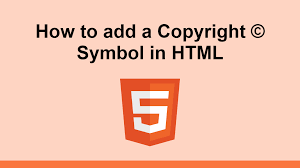HTML Tutorial
- HTML HOME
- HTML Introduction
- HTML Editors
- HTML Basics
- HTML Comments
- HTML Elements
- HTML Attributes
- HTML Headings
- HTML Paragraphs
- HTML Styles
- HTML Text Formatting
- HTML Quotations
- HTML Colors
- HTML Links
- HTML Images
- HTML Favicons: How to Add and Optimize for All Browsers
- HTML Page Title: How to Optimize Titles for SEO Success
- HTML Tables: Create & Optimize for Better Web Design | Codeezy
- HTML Lists: Types, Examples & SEO Tips for Better Structure
- HTML Block and Inline Elements
- HTML Iframes
- HTML File Paths
- HTML Layout
- HTML Computer Code Elements
- HTML Semantics
- HTML5 Semantics
- HTML Entities
- HTML Symbols
- HTML Emojis
- HTML Charsets
HTML Symbols

HTML symbols, also known as HTML entities, play a crucial role in displaying special characters on web pages. These symbols allow you to display characters that would otherwise be interpreted as HTML code, ensuring that your content is both accurate and visually appealing. This guide delves into the use of HTML symbols, providing examples and best practices tailored for Codeezy.
What Are HTML Symbols?
HTML symbols are a way to include characters in your web pages that are either not easily typed on a keyboard or have special meanings in HTML. These symbols are defined by using an ampersand (&), followed by a code or name, and ending with a semicolon (;).
For example, to display the less-than sign (<), which is also used to start an HTML tag, you would use the HTML entity <.
Commonly Used HTML Symbols
Mathematical Symbols:
+→ +−→ −×→ ×÷→ ÷
Currency Symbols:
$→ $€→ €£→ £¥→ ¥
Special Characters:
©→ ©®→ ®™→ ™&→ &
Using HTML Symbols in Code
Here’s an example of how you can use HTML symbols in a web page:
<!DOCTYPE html>
<html lang="en">
<head>
<meta charset="UTF-8">
<meta name="viewport" content="width=device-width, initial-scale=1.0">
<title>HTML Symbols Example</title>
</head>
<body>
<h1>HTML Symbols in Action</h1>
<p>Price: $50 + tax</p>
<p>Company Name © 2024 Codeezy</p>
<p>Equation: 5 × 5 = 25</p>
</body>
</html>
Output:
- Price: $50 + tax
- Company Name © 2024 Codeezy
- Equation: 5 × 5 = 25
Best Practices for Using HTML Symbols
- Consistency: Use HTML symbols consistently across your website to maintain a professional appearance.
- Accessibility: Ensure that symbols are correctly displayed on all devices and browsers.
- SEO Consideration: Using HTML symbols correctly can enhance the readability of your content, which indirectly supports SEO.
Conclusion
HTML symbols are an essential tool for web developers, enabling the precise representation of text on web pages. By mastering the use of these symbols, you can ensure that your content is both visually correct and accessible to all users. The examples provided are tailored for Codeezy, emphasizing real-world applications of HTML symbols in web development.
Thank You for Visiting Codeezy.org!
We’re thrilled to have you as part of our coding community. Your engagement and support inspire us to continue providing high-quality resources and tools to enhance your web development journey. Whether you’re a beginner or an experienced coder, we hope you found valuable insights and tools here at Codeezy.
Stay connected for more tips, tutorials, and updates to help you code with ease. Thank you for choosing Codeezy.org—your growth as a developer is our motivation!
Happy coding!
